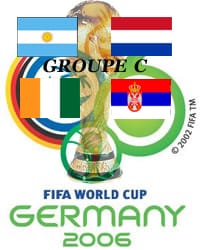Argentina, the Netherlands, Ivory Coast, and Serbia Montenegro make up Group C of the 2006 World Cup. In football terms, this is called the “group of death.” Why? Simply because each of these four nations can legitimately expect to qualify for the knockout stages. Just mentioning the star strikers from each team is enough to convince you: Hernan Crespo, Didier Drogba, Ruud Van Nistelrooy, Mateja Kezman.
Will 2006 be a repeat of 2002 for Argentina? Indeed, in 2002 in Japan, the Argentinians led by their captain Gabriel Batistuta had to face Nigeria, England, and Sweden in the first round. It was also the Group of Death, and Argentina did not survive it. Their elimination, like that of France, constituted the big surprises of that Asian World Cup.
The Argentine people will not forgive a second consecutive failure. Coach José Pekerman has bet on youth, including the Barça sensation Lionel Messi (19 years old) and Carlos Tevez (22 years old) in attack, with Javier Mascherano (22 years old) in the midfield. In defense, he relies on the experienced Roberto Ayala, former Parisians Gabriel Heinze and Juan Pablo Sorín, and has done without the veterans Walter Samuel and Javier Zanetti. To this iron defense, add a lively and technical midfield with Pablo Aimar, Juan Riquelme, Esteban Cambiasso, who must supply an impressive attack comprised of Hernan Crespo, Carlos Tevez… Argentina has little to envy its Brazilian neighbor. The team assembled by Pekerman is dream-worthy on paper. Now, they must confirm their abilities on the field against formidable opponents.
Marco Van Basten has done some housecleaning in the Dutch squad. He has opted to rejuvenate his team by sidelining some key players like Clarence Seedorf and Edgar Davids. This team will be out for redemption. The past years have been tough for the Dutch with, for example, their failure to qualify for the 2002 World Cup. They are eager to redeem themselves in front of fans who will undoubtedly come out in force to support the Oranges. To qualify, the Dutch finished first by dominating Romania and the Czech Republic. The Dutch team appears very balanced, both solid and experienced with players like goalkeeper Edwin Van Der Sar, Giovanni Van Bronckhorst, and Marc Van Bommel, as well as youthful and spirited players like Arjen Robben, Rafael Van der Vaart, and Robin Van Persie. Ruud Van Nistelrooy will be tasked with capitalizing on Dutch chances. The Netherlands has the means to go far in this competition provided they emerge from this group.
The Serbians combine technique and rigor. They are perhaps too quickly overlooked. No one is talking about them. And why couldn’t it be Serbia coming out of the group of death? They had the best defense in the qualifiers with only one goal conceded against Spain. Their group was not easy, featuring Spain, Belgium, and Bosnia-Herzegovina. By finishing first, the Serbians demonstrated that they must be taken seriously. A solid defense, a technical midfield, and effective strikers, the “Brazilians of Europe” will be tough to beat and could create a sensation. Among the four teams in the pool, they have the least pressure. This is often crucial for playing freely. Key players include Dejan Stankovic, Pedrag Djordjevic, the strikers Mateja Kezman and Savo Milosevic. Former Parisian Danijel Ljuboja will also be closely watched.
Ivory Coast nearly commands as much attention as the French Team from all the media. Didier Drogba is on the front pages: portraits, interviews… Henri Michel, the French coach of Ivory Coast, regularly opens his locker room to cameras. Consequently, Ivory Coast is no longer an unknown, unexpected team like past African surprises: Cameroon in 1990, Nigeria in 1994, or Senegal in 2002. These teams played without pressure. That won’t be the case for the Ivorian Elephants. We know almost all the players: the former Marseillais Didier Drogba, of course, but also Parisian Bonaventure Kalou, the Lens player Aruna Dindane, the Saint-Etienne player Didier Zokora, and obviously the player from Nice, whose appearances we will scrutinize. The backbone of the Ivorian selection plays in Ligue 1, but they will also count on Kolo Touré, the robust Arsenal defender, Marc Zoro, the fullback from Messina (Serie A), and Aruna Koné, the dynamic striker from PSV Eindhoven.
The four teams in the group of death share similar characteristics. They are technical and quick. The Serbians, perhaps less speedy, will rely on a better defense. The difference may well lie in that sector. Every match in this Group C will be eagerly awaited. We look forward to June 10 with Argentina-Ivory Coast and June 11 with Serbia Montenegro-Netherlands.
Editorial prediction of Nice Première:
1-Argentina 2-Serbia Montenegro 3-Netherlands 4-Ivory Coast
Schedule for Group C:
June 10 in Hamburg: Argentina – Ivory Coast (21h)
June 11 in Leipzig: Serbia Montenegro – Netherlands (15h)
June 16 in Gelsenkirchen: Argentina – Serbia Montenegro (15h)
June 16 in Stuttgart: Netherlands – Ivory Coast (18h)
June 21 in Frankfurt: Netherlands – Argentina (21h)
June 21 in Munich: Serbia Montenegro – Ivory Coast (21h)


